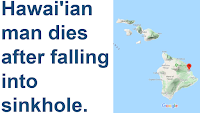Mount Kilauea, a 1247 m shield volcano (dome shaped volcano made up largely of layers of lava) on eastern Hawai'i (or 'Big') Island, began a new eruption on Wednesday 7 June 2023, according to a press release issued by the United States Geological Survey and the Hawaiian Volcano Observatory. The volcano began erupting at slightly before 4.45 am local time, rapidly forming a lava lake within its crater. This was followed by the formation of an ash plume which reached 2500-3000 m above sealevel, prompting the issue of an aviation warning.
The islands of Hawai'i have formed as a result of hotspot volcanism, with a mantle plume hotspot currently located under Big Island, Hawai'i, and each of the other islands being the result of previous activity from the same hotspot, with the oldest Islands in the northwest and newest in the southeast. A volcanic hotspot is an area where magma from deep inside the Earth is welling up through the overlying plate (in this case the Pacific) to create volcanism at the surface. Volcanoes move as they erupt, swelling as magma enters their chambers from bellow, then shrinking as that magma is vented as lava.
See also...
Follow Sciency Thoughts on Facebook.
Follow Sciency Thoughts on Twitter.








